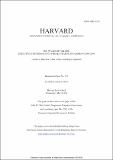| dc.contributor.author | Bebchuk, Lucian Arye | |
| dc.contributor.author | Cohen, Alma | |
| dc.contributor.author | Spamann, Holger | |
| dc.date.accessioned | 2014-04-03T02:35:19Z | |
| dc.date.issued | 2010 | |
| dc.identifier.citation | Lucian A. Bebchuk, Alma Cohen & Holger Spamann, The Wages of Failure: Executive Compensation at Bear Stearns and Lehman 2000-2008, 27 Yale J. on Reg. 257 (2010). | en_US |
| dc.identifier.issn | 0741-9457 | en_US |
| dc.identifier.uri | http://nrs.harvard.edu/urn-3:HUL.InstRepos:12025608 | |
| dc.description.abstract | The standard narrative of the meltdown of Bear Stearns and Lehman Brothers assumes that the wealth of the top executives of these firms was largely wiped out along with their firms. In the ongoing debate about regulatory responses to the financial crisis, commentators have used this assumed fact as a basis for dismissing both the role of compensation structures in inducing risk-taking and the potential value of reforming such structures. This paper provides a case study of compensation at Bear Stearns and Lehman during 2000-2008 and concludes that this assumed fact is incorrect.
We find that the top-five executive teams of these firms cashed out large amounts of performance-based compensation during the 2000-2008 period. During this period, they were able to cash out large amounts of bonus compensation that was not clawed back when the firms collapsed, as well as to pocket large amounts from selling shares. Overall, we estimate that the top executive teams of Bear Stearns and Lehman Brothers derived cash flows of about $1.4 billion and $1 billion respectively from cash bonuses and equity sales during 2000-2008. These cash flows substantially exceeded the value of the executives’ initial holdings in the beginning of the period, and the executives’ net payoffs for the period were thus decidedly positive. The divergence between how the top executives and their shareholders fared implies that it is not possible to rule out, as standard narratives suggest, that the executives’ pay arrangements provided them with excessive risk-taking incentives. We discuss the implications of our analysis for understanding the possible role that pay arrangements have played in the run-up to the financial crisis and how they should be reformed going forward. | en_US |
| dc.language.iso | en_US | en_US |
| dc.publisher | Yale Journal on Regulation | en_US |
| dc.relation.hasversion | http://papers.ssrn.com/sol3/papers.cfm?abstract_id=1513522 | en_US |
| dash.license | OAP | |
| dc.subject | Lehman Brothers, Bear Stearns, the financial crisis, banks, executive compensation, risk-taking, compensation structures, bonus compensation, stock options, restricted shares, moral hazard | en_US |
| dc.title | The Wages of Failure: Executive Compensation at Bear Stearns and Lehman 2000-2008 | en_US |
| dc.type | Journal Article | en_US |
| dc.description.version | Accepted Manuscript | en_US |
| dc.relation.journal | Yale Journal on Regulation | en_US |
| dash.depositing.author | Spamann, Holger | |
| dc.date.available | 2014-04-03T02:35:19Z | |
| dash.contributor.affiliated | Bebchuk, Lucian | |
| dash.contributor.affiliated | Cohen, Alma | |
| dash.contributor.affiliated | Spamann, Holger | |


